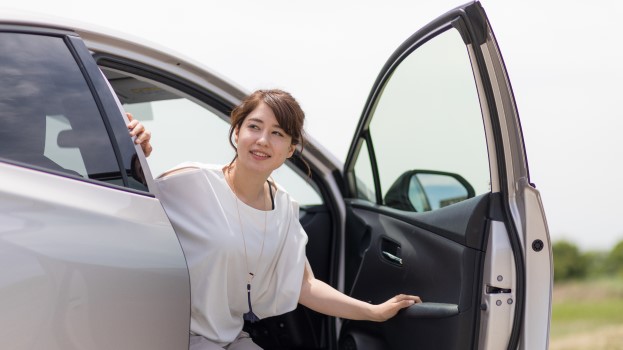To help you reduce your road risk, we've pulled together these road safety tips and resources for safer driving.

Above: the Dutch Reach technique of opening a car door means that you automatically look behind you, and can easily become a habit.
No need for speed
Speed contributes to one in five fatal crashes in the UK. Small increases in speed lead to bigger increases in stopping distances, and a crash at 30mph involves twice as much energy and destructive potential as a crash at 20mph.
At slower speeds, drivers have better vehicle control, more time to see and avoid hazards, and greater ability to stop in time and avoid a crash.
- Never exceed local speed limits. Adapt speed to 20mph in built up and residential areas.
- Drive at safe and appropriate speeds in adverse weather conditions.
Video: Limits not targets – why different road environments need different speed limits
Game: Know your stopping distance
Take longer to look
Failing to look properly is a very common cause of road accidents, but is a relatively easy fix.
- Take an extra moment to have a proper look at what's around you and what's coming before pulling out of a road, changing lanes or opening your car door while stationary.
- Try the Dutch Reach: Open the car door with the hand furthest from the handle so that you turn your head to look behind you, helping you to see approaching cyclists. The more you do this, the more it will become a habit.
Boost your energy levels
There’s a clear relationship between the food and drink you consume and your energy levels. The right food and drink can help to reduce fatigue and increase concentration.
- Staying hydrated, eating nutritious food and sticking to a balanced diet, can keep your mind focused on the road.
- Think: is your lunch going to boost your energy levels or leave you feeling sluggish?
Anticipate other road users
The Highway Code says: “Wait until there is a safe gap between you and any oncoming vehicle.”
- Try to judge the path and speed of other vehicles when on the road. Many accidents occur because a driver misjudges a gap when merging onto a motorway, pulling on to a roundabout or thinking that another road user will accommodate a risky move.
- Maintain safe following distance from the vehicle in front.
Don't get distracted
Distractions inside your vehicle, as well as outside, can reduce your concentration.
- Using a mobile phone while driving (even if it’s hands-free) is a factor in many accidents. Park up to make or respond to a call.
- Resist the urge to respond to an incoming text message – it’s not worth the risk. Reading or tapping out texts while driving can be lethal.
- Bring your mind back to the road instead of attempting to multi-task.
How distraction affects driver safety
Consider emotional wellbeing
To prevent accidents, the wellbeing of drivers is critical. Stress has been linked with risk-taking on the roads – 71 per cent of drivers admit to losing their concentration after getting annoyed.
If we can learn to look after ourselves better, we can remain calm and focused while driving.
Find out more
Staying safe on the roads: a quick and simple guide
Tackling work-related road risk: views and shared good practice from our members at our road risk webinar
In brief: CIRAS road safety case studies
Or you can search for full road safety CIRAS reports on our reports page
See also
Driving for Better Business: changing driver behaviour
Driving for Better Business: van driver toolkit
Driving for Better Business: resource library
Brake: the road safety charity
The Highway Code (gov.uk)
Tags
- Highways
- Infrastructure Managers
- Bus
- Supply Chain - Infrastructure
